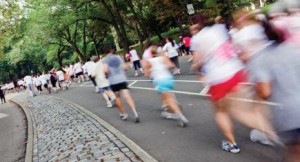Suffering from Shin Splints?
 Well, it’s that time of year again! The sun is warm and the runners are coming out in droves! Did you start out a little too eager and now you are having pain? It is estimated that shin splints account for 10—15% of all running injuries and 60% of all conditions that cause pain in the legs.
Well, it’s that time of year again! The sun is warm and the runners are coming out in droves! Did you start out a little too eager and now you are having pain? It is estimated that shin splints account for 10—15% of all running injuries and 60% of all conditions that cause pain in the legs.
What are the signs and symptoms of shin splints?
Shin splints are characterized by a general, diffuse pain along the inside border of the tibia, in the front of the leg.
Four grades of pain have been outlined:
- Grade I: Pain occurring after athletic activity
- Grade II: Pain occurring before and after athletic activity but not affecting performance
- Grade III: Pain occurring before, during, and after activity and affecting performance
- Grade IV: Pain so severe that activity is not possible
Treatment of Shin Splints
- REST!
- Ice/ice massage
- NSAIDs (if recommended)
- Stretching of lower leg muscles
- Strengthening of lower leg muscles
- Activity/training modification to eliminate pain
- Shoe/equipment evaluation and modification
- Compression with a sleeve or tape
Should I see a doctor?
Referral to a physician may be necessary to rule out a stress fracture, compartment syndrome, or other more serious condition. If pain becomes increasingly worse without activity or the pain becomes more localized, see a physician for an x-ray and other special tests!
Don’t try to run through the pain. If you think that you might have shin splints, see your doctor, asap! He or she may recommend a running analysis and/or physical therapy to get you back to training in no time!
+ Find a primary care physician near you!
+ Learn more about In Motion’s Running program.
